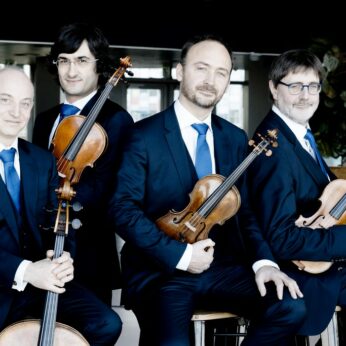Composer: Mieczyslaw Weinberg (b. 1919 - d. 1996)
Performance date: 29/06/2022
Venue: St. Brendan’s Church
Composition Year: 1946
Duration: 00:30:36
Recording Engineer: Simon Cullen, Ergodos
Instrumentation: 2vn, va, vc
Instrumentation Category:String Quartet
Artists:
Quatuor Danel (Marc Danel, Gilles Millet [violins], Vlad Bogdanas [viola], Yovan Markovitch [cello] -
[quartet]

Mieczysław Weinberg [1919-1996]
String Quartet No.6 in E minor Op.35 [1946]
1. Allegro semplice 4. Adagio
2. Presto agitato 5. Moderato commodo
3. Allegro con fuoco 6. Andante maestoso
Weinberg’s stunning six-movement Sixth Quartet dating from 1946 is the highpoint of his extraordinary series of youthful quartets, each one more mesmerising than the previous one. It seemed Weinberg was on the road to an illustrious career as a composer, but, as Shostakovich had found out ten years earlier, success at any level is a dangerous place to occupy in a dictatorship. Before ever his new Quartet could be performed, it was banned in the infamous Prikaz 17 that also picked out top Soviet composers like Shostakovich, Prokofiev and Myaskovsky.
During the War restrictions on the cultural sector were allowed to slide, but from 1947 the deadening hand of Socialist Realism was re-introduced along with a vicious campaign against so-called formalism. This typical by-product of autocratic rule was a pseudo-musicological name for anything the regime did not like; the only safe compositions were Music for the People, tuneful, accessible and folk-like. Worse still the acceptability of new works was determined by Union of Composers committees made up of yes-men with no serious musical ability. Without their approval, new works could not be published or performed. The effect of this system can be seen with Weinberg’s Sixth, it was eventually given its first performance by tonight’s performers in Manchester in 2007, sixty years after its composition. And Weinberg did not compose another quartet until 1957.
The irony is that the Sixth is one of Weinberg’s most accessible quartets. It is on a symphonic scale with six movements, three fast ones to begin, an Adagio fugue and two in-between movements to conclude. The work opens in a familiar manner with a patient unfolding of themes and typical Weinbergian rhythmic ideas with an exposition repeat so we do not get lost. In the development he holds the tension before unleashing an extended climax replete with wild glissandos. As the climax fades the recapitulation is marked by fierce pizzicatos. The coda just subsides gently into silence.
The presto agitato is brief, violent and exciting and is immediately followed by the strange Allegro con fuoco, an interlude that looks back to Beethoven’s theatrical ideas in his late Quartets. Its last bars prepare us for the big central Adagio Fugue that follows. This movement eschews big climaxes and instead looks quietly and patiently inward. The Moderato commodo is another interlude, longer this time, circling around several fragmented themes, a series of spectral pizzicatos, a sudden passionate outburst and a wonderful ethereal coda. The Andante maestoso is a terrific movement, full of power and strength, as if to make up for earlier uncertainties. There are no doubts here, each episode bursting with confidence, even including a little folksong out of nowhere before the final stupendous bars.
Francis Humphrys
Copyright © 2025 West Cork Music. All rights reserved.
Designed and developed by Matrix Internet